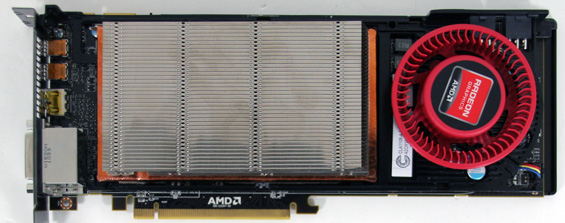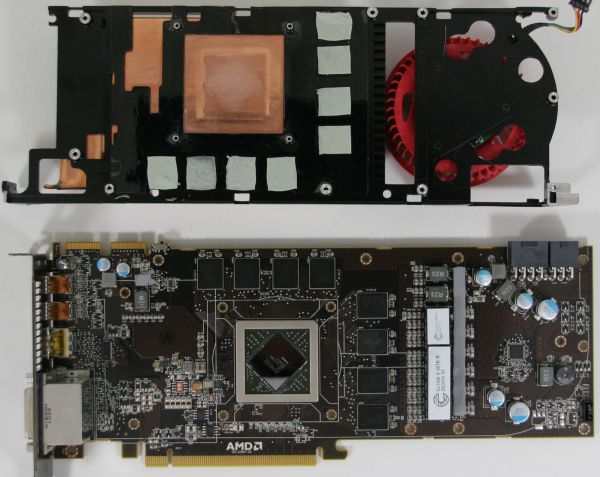AMD's Radeon HD 6970 & Radeon HD 6950: Paving The Future For AMD
by Ryan Smith on December 15, 2010 12:01 AM ESTMeet the 6970 & 6950
Now that we’ve finally looked at what makes the 6900 series tick, let’s look at the cards themselves.
If you’re familiar with the 6800 series, then the 6900 series is nearly identical. For our reference cards AMD is using the same style they used for the 6800 cards, utilizing a completely shrouded and squared off design. Furthermore unlike the 5800 series AMD is utilizing the same cooler/PCB/layout for both the 6970 and 6950, meaning virtually everything we have to say about one card applies to the other as well. In this case we’ll be using the 6970 as our point of reference.
Starting with the length, the 6970 measures a hair over 10.5”, giving it the same length as the 5870. Buyers looking for a 5850-like shorter card will have to look elsewhere else for the moment, as the 6950 is the same 10.5”. Power is provided by a set of 6+8pin PCIe power sockets at the top of the card, necessary as the 6970’s 250W TDP is in excess of the 225W 6+6 limit. The 6950 on the other hand does use 6+6 PCIe power sockets in the same location, afforded by its lower 200W TDP.
Cracking open the 6970 we find the PCB with the Cayman GPU at the center in all its 389mm2 glory. Around it are 8 2Gb Hynix GDDR5 chips, rated for 6Gbps, 0.5Gbps higher than what the card actually runs at. As we’ve said before the hardest part about using GDDR5 at high speeds is the complexity of building a good memory bus, and this continues to be the case here. AMD has made progress on getting GDDR5 speeds up to 5.5Gbps primarily through better PCB designs, but it looks like hitting 6Gbps and beyond is going to be impractical, at least for a 256bit bus design. Ultimately GDDR5 was supposed to top out at 7Gbps, but with the troubles both AMD and NVIDIA have had, we don’t expect anyone will ever reach it.
Moving on to the cooling apparatus, vapor chamber coolers are clearly in vogue this year. AMD already used a vapor chamber last year on the dual-GPU 5970, while this year both AMD and NVIDIA are using them on their high-end single-GPU products. Compared to a more traditional heatpipe cooler, a vapor chamber cooler is both more efficient than a heatpipe cooler and easier to build in to a design as there’s no need to worry about where to route the heatpipes. Meanwhile airflow is provided by a blower at the rear of the card; compared to the 5870 the blower on the 6970 is just a bit bigger, a fair consideration given that the 6970 is a hotter card. Interestingly in spite of the higher TDP AMD has still been able to hold on to the half-height exhaust port at the front of the card.

As for I/O we’re looking at AMD’s new port layout as seen on the 6800 series: 2x DVI, 1x HDMI 1.4, and 2x mini-DP. All together the 6970 can drive up to 6 monitors through the use of the mini-DP ports and a MST hub. Compared to the 5800 series the DVI-type ports have a few more restrictions however; along with the usual limitation of only being able to drive 2 DVI-type monitors at once, AMD has reduced the 2nd DVI port to a single-link port (although it maintains the dual-link pin configuration), so you won’t be able to drive 2 2560 or 3D monitors using DVI ports.

Elsewhere the card features 2 CrossFire connectors at the top, allowing for tri-CF for the particularly rich and crazy. Next to the CF connectors you’ll find AMD’s not-so-secret switch, which controls the cards’ switchable BIOSes. The card has 2 BIOSes, which can be changed with the flick of a switch. The primary purpose of this switch is to offer a backup BIOS in case of a failed BIOS flash, as it’s possible to boot the card with the secondary BIOS and then switch back to the primary BIOS after the computer has started in order to reflash it. Normally AMD doesn’t strike us as very supportive of BIOS flashing, so this is an interesting change.

The BIOS Switch
Like the 5870 the back side is covered with a metal plate, and while there aren’t any components on the back side of the card to protect, this is a nice touch by making it easier to grab the card without needing to worry about coming in contact with a pointy contact.
Finally, while the card’s overall dimensions are practically identical to the 5870, we noticed that the boxy design isn’t doing AMD any favors when it comes to CrossFire mode with 2 cards right next to each other. The 5870’s shroud actually jutted out just a bit at the center, keeping the ventilation hole for the blower from pressing right up against the back of another card. The 6970 does not have this luxury, meaning it’s possible to practically seal the upper card depending on how you screw the cards down. As a result our CF temperatures run high, but not to a troublesome degree. We’d still encourage AMD to take a page from NVIDIA’s book and to bring the shroud in a bit around the blower so that it has more room to breathe, particularly as their TDP is approaching NVIDIA’s. In the meantime we’d definitely suggest spacing your cards apart if you have a motherboard and case that allows it.













168 Comments
View All Comments
MeanBruce - Wednesday, December 15, 2010 - link
TechPowerUp.com shows the 6850 as 95percent or almost double the performance of the 4850 and 100percent more efficient than the 4850@1920x1200. I also am upgrading an old 4850, as far as the 6950 check their charts when they come up later today.mapesdhs - Monday, December 20, 2010 - link
Today I will have completed by benchmark pages comparing 4890, 8800GT and
GTX 460 1GB (800 and 850 core speeds), in both single and CF/SLI, for a range
of tests. You should be able to extrapolate between known 4850/4890 differences,
the data I've accumulated, and known GTX 460 vs. 68xx/69xx differences (baring
in mind I'm testing with 460s with much higher core clocks than the 675 reference
speed used in this article). Email me at mapesdhs@yahoo.com and I'll send you
the URL once the data is up. I'm testing with 3DMark06, Unigine (Heaven, Tropics
and Sanctuary), X3TC, Stalker COP, Cinebench, Viewperf and PT Boats. Later
I'll also test with Vantage, 3DMark11 and AvP.
Ian.
ZoSo - Wednesday, December 15, 2010 - link
Helluva 'Bang for the Buck' that's for sure! Currently I'm running a 5850, but I have been toying with the idea of SLI or CF. For a $300 difference, CF is the way to go at this point.I'm in no rush, I'm going to wait at least a month or two before I pull any triggers ;)
RaistlinZ - Wednesday, December 15, 2010 - link
I'm a bit underwhelmed from a performance standpoint. I see nothing that will make me want to upgrade from my trusty 5870.I would like to see a 2x6950 vs 2x570 comparison though.
fausto412 - Wednesday, December 15, 2010 - link
exactly my feelings.it's like thinking Miss Universe is about to screw you and then you find out it's her mom....who's probably still hot...but def not miss universe
Paladin1211 - Wednesday, December 15, 2010 - link
CF scaling is truly amazing now, I'm glad that nVidia has something to catch up in terms of driver. Meanwhile, the ATI wrong refresh rate is not fixed, it stucks at 60hz where the monitor can do 75hz. "Refresh force", "refresh lock", "ATI refresh fix", disable /enable EDID, manually set monitor attributes in CCC, EDID hack... nothing works. Even the "HUGE" 10.12 driver can't get my friend's old Samsung SyncMaster 920NW to work at its native 1440x900@75hz, both in XP 32bit and win 7 64bit. My next monitor will be an 120hz for sure, and I don't want to risk and ruin my investment, AMD.mapesdhs - Monday, December 20, 2010 - link
I'm not sure if this will help fix the refresh issue (I do the following to fix max res
limits), but try downloading the drivers for the monitor but modify the data file
before installing them. Check to ensure it has the correct genuine max res and/or
max refresh.
I've been using various models of CRT which have the same Sony tube that can
do 2048 x 1536, but every single vendor that sells models based on this tube has
drivers that limited the max res to 1800x1440 by default, so I edit the file to enable
2048 x 1536 and then it works fine, eg. HP P1130.
Bit daft that drivers for a monitor do not by default allow one to exploit the monitor
to its maximum potential.
Anyway, good luck!!
Ian.
techworm - Wednesday, December 15, 2010 - link
future DX11 games will stress GPU and video RAM incrementally and it is then that 6970 will shine so it's obvious that 6970 is a better and more future proof purchase than GTX570 that will be frame buffer limited in near future gamesNickel020 - Wednesday, December 15, 2010 - link
In the table about whether PowerTune affects an application or not there's a yes for 3DMark, and in the text you mention two applications saw throttling (with 3DMark it would be three). Is this an error?Also, you should maybe include that you're measuring the whole system power in the PowerTune tables, it might be confusing for people who don't read your reviews very often to see that the power draw you measured is way higher than the PowerTune level.
Reading the rest now :)
stangflyer - Wednesday, December 15, 2010 - link
Sold my 5970 waiting for 6990. With my 5970 playing games at 5040x1050 I would always have a 4th extended monitor hooked up to a tritton uve-150 usb to vga adapter. This would let me game while having the fourth monitor display my teamspeak, afterburner, and various other things.Question is this!! Can i use the new 6950/6970 and use triple monitor and also use a 4th screen extended at the same time? I have 3 matching dell native display port monitors and a fourth with vga/dvi. Can I use the 2 dp's and the 2 dvi's on the 6970 at the same time? I have been looking for this answer for hours and can't find it! Thanks for the help.